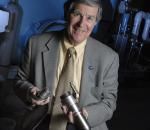North Olmsted Class Reunions
North Olmsted, Ohio (OH)
Alumni Stories
Dr. Clark W. Hawk
Class of 1954
Clark W. Hawk, 71, of Madison passed away February 26, 2008.. Even though his high school counselor said, "you will never be an engineer", Dr. Hawk went on to make a world-wide impact in the propulsion engineering field. Dr. Hawk received his bachelor's mechanical engineering degree from Pennsylvania State University in 1958, his master's degree in 1968 and his Ph.D. in 1970 from Purdue University. He retired as director of the Propulsion Division at the Air Force Rocket Propulsion Laboratory at Edwards Air Force Base, California, where he served from 1958 to 1991. He taught engineering in Tachikawa, Japan for the University of Southern California. He was founder and director of UAH Propulsion Research Center and professor of Mechanical and Aerospace Engineering at UAH. He was a fellow of the American Institute of Aeronautics and Astronautics, as well as, the NASA Institute for Advanced Concepts. Dr. Hawk was an executive member of the Army/Navy/NASA/Air Force Propulsion Group and advisor to Congress on National Space Transportation Policy. Dr. Hawk received the Lifetime Achievement Award from the JANNAF Executive Committee and The Hermann Oberth Award for Outstanding Scientific Achievement in the fields of Aeronautics and the Space Sciences from the AIAA. He was an elder and teacher in the Presbyterian church. He taught amateur ice hockey, was an avid supporter of the UAH hockey team and played in senior men's baseball tournaments. While in Lancaster, Calif., he was a member of the Antelope Valley School Board for nine years. He also enjoyed ballroom dancing with his wife, Julia. Dr. Hawk's favorite Bible verse was Isaiah 40:31, "but those who hope in the Lord will renew their strength. They will soar on wings like eagles; they will run and not grow weary, they will walk and not be faint".
The Huntsville Times published on Feb. 29, 2008: When Dr. Clark Hawk got to the University of Alabama in Huntsville in 1991, the Propulsion Research Center was nothing more than an idea, a couple of desks and a few computers. Today the center Hawk directed for 17 years has grown to one that generates about $3.5 million in research grants each year and produces rocket scientists who go on to work in some of the top industries. Hawk, said Dr. Bob Frederick, the center's associate director, "was a visionary." The center has 17 graduate and 14 undergraduate students on staff. Since 1991, the program has produced 24 Ph.Ds and 90 master's degrees. While running the center, Hawk also taught classes and went through the tenure process to become a full professor of mechanical and aerospace engineering. In 2005 he received a research award from UAH which was in recognition of the center's work
Propulsion Technology Mostly Unchanged After 50 Years
Libraries
Science News KeywordsSPACE, SPACE EXPLORATION, SPACE
ANNIVERSARY, PROPULSION, ROCKETS
Contact Information
Available for logged-in reporters only
Description
It's been a half century since America entered the space age. The basic propulsion concepts will be the same as we begin the next half century of space exploration. However, there have been technological strides that make current propulsion systems superior to those early rocket engines.
Newswise — Although it's been a half century since America entered the space age, the basic propulsion
concepts used to push Explorer I into space will be the same type of propulsion that the nation will use to
begin the next half century of space exploration. It was January 31, 1958 when a Redstone-Jupiter C
rocket developed in Huntsville, Ala., lifted the 30-pound artificial satellite into space.
Clark Hawk, director of the Propulsion Research Center at The University of Alabama in Huntsville
(UAHuntsville) has seen most of the advances that have taken place in rocket propulsion. He has spent
50 years conducting research in the field. "Chemical propulsion will be with us for the foreseeable future as the means to escape the Earth’s gravity," said Dr. Hawk, who worked with the Air Force Propulsion Laboratory at Edwards Air Force base, before joining UAHuntsville nearly 20 years ago.
"Large forces are required for periods of several minutes to accomplish this and chemical systems do
this well and relatively cheaply," he said. Hawk, however, concedes there have been technological strides that make current propulsion systems superior to those early engines. NASA is making plans to return to the moon in the next decade. The nation's space agency is using rocket motors similar in design to the Saturn launch vehicles but will incorporate newer features. These new engines, called J-2 during the 1960s development of Saturn vehicles, will be called J-2X.
"There have been advances in materials and hardware design that one might wish to incorporate into the J-2X," Hawk said. "For example, the coolant of the J-2 thrust chamber passed through a number of tubes arranged in parallel. The new design would use the milled channel fabrication method used on the space shuttle main engine. "It features improved heat transfer through the use of copper alloy materials and the 'fin effect' attendant to that design concept. The injector, which is the heart of the engine, would benefit from advancements in understanding of the effects of various design features upon performance and combustion stability since the initial development of the J-2."
Hawk's research center at UAHuntsville has unique research capabilities that will provide NASA and contractors a greater measure of safety and performance. "We have the ability to run rockets on campus with both liquid oxygen and liquid methane. Also, we have a unique combustion stability research tool of which there are only three in the world and ours is the only one in the U.S.A. “This gives us a research tool for evaluating the combustion stability of a single, full scale, injector element," Hawk
said. "We could, conceivably, test a variety of injector designs of interest to NASA in order to evaluate their combustion stability characteristics. "The bench scale hardware is a low-cost approach to obtaining data applicable to full scale injector elements and would facilitate through evaluation of a number of concepts to help identify the most promising designs. Having better knowledge of an injector’s susceptibility to combustion instability is an essential ingredient to arriving at a design that will enhance mission safety."
Meanwhile, as UAHuntsville continues to look at ways to make improvements in chemical propulsion technologies, the university's researchers continue to investigate future propulsion concepts.
"The application of advanced propulsion concepts such as plasma propulsion devices or others that rely upon energy sources other than chemical is for in-space use," Hawk said. However, he explained that while NASA is not actively pursuing these devices currently, the university continues that research.
"We continue to work such advanced devices to continue to provide better understanding of the associated physics so that when NASA is able to bring its attention to the next level of propulsion needs, we will have provided a foundation from which to build."
© 2008 Newswise. All Rights Reserved.
The Huntsville Times published on Feb. 29, 2008: When Dr. Clark Hawk got to the University of Alabama in Huntsville in 1991, the Propulsion Research Center was nothing more than an idea, a couple of desks and a few computers. Today the center Hawk directed for 17 years has grown to one that generates about $3.5 million in research grants each year and produces rocket scientists who go on to work in some of the top industries. Hawk, said Dr. Bob Frederick, the center's associate director, "was a visionary." The center has 17 graduate and 14 undergraduate students on staff. Since 1991, the program has produced 24 Ph.Ds and 90 master's degrees. While running the center, Hawk also taught classes and went through the tenure process to become a full professor of mechanical and aerospace engineering. In 2005 he received a research award from UAH which was in recognition of the center's work
Propulsion Technology Mostly Unchanged After 50 Years
Libraries
Science News KeywordsSPACE, SPACE EXPLORATION, SPACE
ANNIVERSARY, PROPULSION, ROCKETS
Contact Information
Available for logged-in reporters only
Description
It's been a half century since America entered the space age. The basic propulsion concepts will be the same as we begin the next half century of space exploration. However, there have been technological strides that make current propulsion systems superior to those early rocket engines.
Newswise — Although it's been a half century since America entered the space age, the basic propulsion
concepts used to push Explorer I into space will be the same type of propulsion that the nation will use to
begin the next half century of space exploration. It was January 31, 1958 when a Redstone-Jupiter C
rocket developed in Huntsville, Ala., lifted the 30-pound artificial satellite into space.
Clark Hawk, director of the Propulsion Research Center at The University of Alabama in Huntsville
(UAHuntsville) has seen most of the advances that have taken place in rocket propulsion. He has spent
50 years conducting research in the field. "Chemical propulsion will be with us for the foreseeable future as the means to escape the Earth’s gravity," said Dr. Hawk, who worked with the Air Force Propulsion Laboratory at Edwards Air Force base, before joining UAHuntsville nearly 20 years ago.
"Large forces are required for periods of several minutes to accomplish this and chemical systems do
this well and relatively cheaply," he said. Hawk, however, concedes there have been technological strides that make current propulsion systems superior to those early engines. NASA is making plans to return to the moon in the next decade. The nation's space agency is using rocket motors similar in design to the Saturn launch vehicles but will incorporate newer features. These new engines, called J-2 during the 1960s development of Saturn vehicles, will be called J-2X.
"There have been advances in materials and hardware design that one might wish to incorporate into the J-2X," Hawk said. "For example, the coolant of the J-2 thrust chamber passed through a number of tubes arranged in parallel. The new design would use the milled channel fabrication method used on the space shuttle main engine. "It features improved heat transfer through the use of copper alloy materials and the 'fin effect' attendant to that design concept. The injector, which is the heart of the engine, would benefit from advancements in understanding of the effects of various design features upon performance and combustion stability since the initial development of the J-2."
Hawk's research center at UAHuntsville has unique research capabilities that will provide NASA and contractors a greater measure of safety and performance. "We have the ability to run rockets on campus with both liquid oxygen and liquid methane. Also, we have a unique combustion stability research tool of which there are only three in the world and ours is the only one in the U.S.A. “This gives us a research tool for evaluating the combustion stability of a single, full scale, injector element," Hawk
said. "We could, conceivably, test a variety of injector designs of interest to NASA in order to evaluate their combustion stability characteristics. "The bench scale hardware is a low-cost approach to obtaining data applicable to full scale injector elements and would facilitate through evaluation of a number of concepts to help identify the most promising designs. Having better knowledge of an injector’s susceptibility to combustion instability is an essential ingredient to arriving at a design that will enhance mission safety."
Meanwhile, as UAHuntsville continues to look at ways to make improvements in chemical propulsion technologies, the university's researchers continue to investigate future propulsion concepts.
"The application of advanced propulsion concepts such as plasma propulsion devices or others that rely upon energy sources other than chemical is for in-space use," Hawk said. However, he explained that while NASA is not actively pursuing these devices currently, the university continues that research.
"We continue to work such advanced devices to continue to provide better understanding of the associated physics so that when NASA is able to bring its attention to the next level of propulsion needs, we will have provided a foundation from which to build."
© 2008 Newswise. All Rights Reserved.

Recent Members
| Dan Bartuccio | 1968 |
| Greg Kearney | 1987 |
| Jason Bot | 2006 |
| John Dodd | 1974 |
| John Gaetano | 1977 |
| Kristine Haas | 1987 |
| Timothy Gaffney | 1974 |
| Victor Black | 1985 |
Military Alumni
Honoring Our Heroes
This area is dedicated to our alumni that have served or are serving in our armed forces!
Lost Class Rings
Have you lost your North Olmsted class ring? Have you found someone's class ring? Visit our Eagles lost class ring page to search for your class ring or post information about a found ring.
Do you have a fun holiday story or a great family tradition? Share them with our fellow North Olmsted alumni! Submit your own stories, achievements and photos in our Alumni Stories section. Read other classmate’s stories and see what they have been up to over the years.
Happy Holidays!
Happy Holidays!


